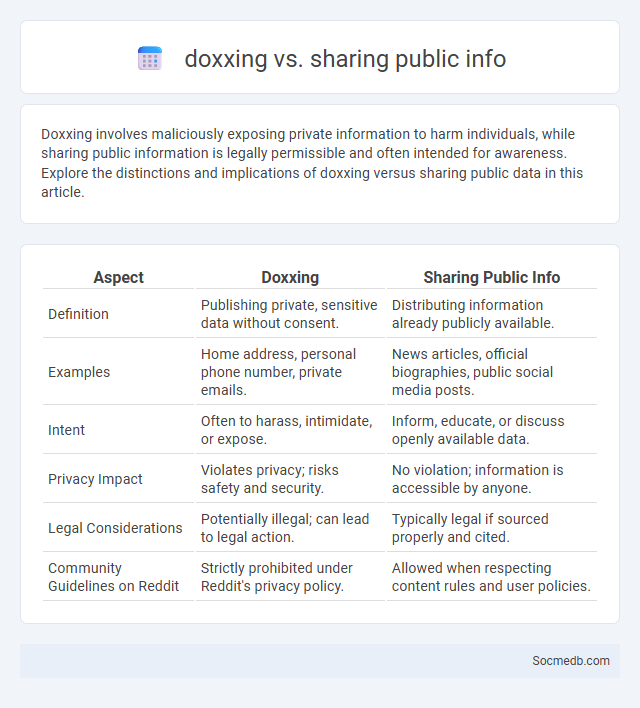
Photo illustration: doxxing vs sharing public info
Doxxing involves maliciously exposing private information to harm individuals, while sharing public information is legally permissible and often intended for awareness. Explore the distinctions and implications of doxxing versus sharing public data in this article.
Table of Comparison
| Aspect | Doxxing | Sharing Public Info |
|---|---|---|
| Definition | Publishing private, sensitive data without consent. | Distributing information already publicly available. |
| Examples | Home address, personal phone number, private emails. | News articles, official biographies, public social media posts. |
| Intent | Often to harass, intimidate, or expose. | Inform, educate, or discuss openly available data. |
| Privacy Impact | Violates privacy; risks safety and security. | No violation; information is accessible by anyone. |
| Legal Considerations | Potentially illegal; can lead to legal action. | Typically legal if sourced properly and cited. |
| Community Guidelines on Reddit | Strictly prohibited under Reddit's privacy policy. | Allowed when respecting content rules and user policies. |
Understanding Doxxing: Definition and Implications
Doxxing involves the malicious act of publishing private or identifiable information about an individual online without consent, often leading to harassment or threats. This practice undermines digital privacy, threatening personal safety and reputation, and can have severe psychological and legal consequences. Understanding doxxing's methods and impact is essential for promoting safer social media environments and protecting user data.
What Constitutes Publicly Available Information
Publicly available information on social media includes any data that users share without privacy restrictions, such as profile details, posts, comments, and photos accessible to all users or search engines. This data is often indexed by search engines and can be collected by third parties, making it critical to understand your privacy settings and the platform's terms of service. You should regularly review what content is visible to ensure your digital footprint aligns with your personal or professional boundaries.
The Fine Line: Doxxing vs. Sharing Public Info
Doxxing involves maliciously exposing private information without consent, often leading to harassment or harm, whereas sharing public info pertains to distributing already accessible data responsibly. The ethical implications hinge on intent, context, and the sensitivity of the disclosed information, making vigilance essential on social media platforms. Users must balance transparency with privacy, respecting digital boundaries to prevent misuse and protect individual rights.
Rule Violations and Platform Guidelines Explained
Social media platforms enforce strict rule violations policies to maintain safe and respectful online environments, including prohibiting hate speech, harassment, and misinformation. Each platform's community guidelines outline specific prohibited behaviors and content, aiming to protect users while promoting authentic interactions. Understanding and adhering to these regulations is crucial for users to avoid penalties such as content removal, account suspension, or permanent bans.
Legal Perspectives on Doxxing and Information Sharing
Doxxing involves the unauthorized sharing of private or identifying information, raising significant legal concerns around privacy violations and potential harassment. Laws vary by jurisdiction, but many countries recognize doxxing as an offense under cyberstalking, harassment, or data protection statutes. Protecting Your online presence requires understanding these legal frameworks to prevent unlawful disclosure and to respond effectively if targeted by doxxing activities.
Ethical Considerations in Online Information Disclosure
Maintaining ethical considerations in online information disclosure is crucial to protect personal privacy and prevent misuse of sensitive data on social media platforms. You should carefully evaluate what information you share, ensuring it does not compromise your security or the consent of others involved. Transparency and respect for digital boundaries uphold trust and promote responsible social media interactions.
Potential Consequences of Doxxing and Rule Breaches
Doxxing on social media can lead to severe privacy violations, exposing individuals to harassment, identity theft, and emotional distress. Breaching platform rules often results in account suspensions, loss of credibility, and legal repercussions depending on the severity of the offense. Enforcing strict guidelines is crucial to protect users and maintain a safe online community.
Preventing Doxxing: Best Practices for Online Safety
Preventing doxxing requires strong online privacy settings, including limiting personal information shared on social media platforms like Facebook, Twitter, and Instagram. Using pseudonyms, enabling two-factor authentication, and regularly reviewing friend lists reduces the risk of exposure to malicious actors. Employing tools such as VPNs and privacy-focused browsers enhances anonymity and safeguards sensitive data from doxxing attempts.
Responding to Doxxing and Rule Violations
Responding to doxxing on social media requires immediate action by reporting the content to platform moderators and utilizing privacy settings to protect personal information. Enforcing community guidelines involves monitoring posts for rule violations such as harassment or hate speech and applying appropriate sanctions like content removal or account suspension to maintain a safe environment. Effective response strategies enhance user trust and promote responsible digital behavior.
Creating a Respectful Online Community
Creating a respectful online community fosters positive interactions, encourages diverse perspectives, and reduces harmful behavior such as cyberbullying. You can contribute by practicing empathy, using inclusive language, and addressing conflicts calmly. Building a supportive digital environment enhances trust and promotes meaningful connections across social media platforms.
 socmedb.com
socmedb.com